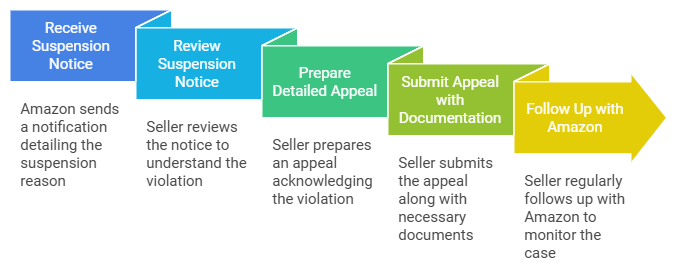Amazon Section 3 Violation: The Silent Suspension Clause Every Seller Should Fear
Amazon Section 3 Violation: The Silent Suspension Clause Every Seller Should Fear
The Clause Nobody Reads - Until It’s Too Late
Most Amazon sellers don’t lie awake at night thinking about the Business Solutions Agreement. It’s the legal boilerplate you scroll past during account registration – the wall of text no one really reads. You’re focused on optimizing your listings, managing ads, hitting your metrics. That agreement seems like background noise.
Until one day, it’s not.
Because buried deep inside that document is Section 3 – Amazon’s go-to clause for account termination. It’s not about ASIN policy violations. It’s not triggered by a metrics dip. It’s broader, more final, and far more terrifying.
This section gives Amazon the legal right to shut down your entire seller account immediately if they believe you’ve become a risk. And when it happens, there’s no advance warning, no performance notification countdown – just a cold message: “Your Amazon seller account has been deactivated under Section 3 of the Business Solutions Agreement.”
This article unpacks what that actually means, how to survive it, and what sellers can do to rebuild, recover, or prevent it from happening in the first place.
The Seller Who Thought They Were Safe
Let’s make this real.
Olivia had been selling on Amazon for over four years. She ran a clean account. Great performance metrics. Top-rated feedback. She sold a line of handmade home spa kits and was even featured in a popular lifestyle blog. Nothing flashy – but consistent, compliant, and profitable.
Until the morning she opened Seller Central and saw a message she didn’t understand: “Your account has been deactivated under Section 3.”
No ASIN flagged. No clear reason. No metrics failure. Her listings disappeared. Her payouts were frozen. Her inventory was locked in FBA. Support gave her nothing but templated replies. She was stuck.
What happened? As it turned out, her supplier had recently been linked to another suspended seller accused of selling counterfeit inventory. Olivia’s goods were authentic – but to Amazon, the risk of association was enough.
This is what makes a Section 3 violation so brutal. It doesn’t just judge what you did – it judges who you’re connected to, what Amazon thinks might happen, and whether they want to take that risk. And when they make that call, they end the agreement. Completely.
What Is a Section 3 Violation, Really?
Amazon’s marketplace is governed by one thing above all else: trust. Trust that products are real. Trust that delivery is fast. Trust that the seller isn’t operating in a legal gray area.
But Amazon’s risk tolerance is shrinking.
With increased regulatory scrutiny, international compliance demands, and a surge in counterfeit complaints, Amazon now leans on Section 3 like never before. It’s a tool of preemptive defense. They don’t want to wait until something goes wrong – they want to eliminate anything that might go wrong before it hits the press.
That’s why sellers are seeing more accounts terminated under this clause without a single policy warning.
In their view: if there’s even a shadow of doubt – they cut ties.
What Triggers a Section 3 Suspension?
Contrary to what many believe, Section 3 isn’t about metrics – it’s about perceived risk.
Some common triggers include:
Multiple buyers claiming your products are not as described, expired, or counterfeit – even without verified proof
Use of language in listings that implies false or unsubstantiated medical or compliance claims (e.g., “FDA-approved” when it’s not)
Activity that matches patterns Amazon associates with known fraudulent or deceptive behavior
Related account suspensions (sharing an IP address, supplier, or prep center with another banned seller)
Repeat buyer complaints around authenticity, even if your documentation is legitimate
These are signals Amazon’s risk teams monitor in real time. And once the system pushes the flag, Section 3 gives them the legal pathway to shut you down without needing to validate every detail.
What to Do After You’ve Been Suspended Under Section 3
This isn’t a typical ASIN suspension. You’re not correcting a minor infraction. You’re trying to reverse Amazon’s loss of trust in you.
Start by documenting everything: sourcing, invoices, tracking history, customer service logs. Conduct a full internal review of your supply chain and fulfillment systems.
Then, draft a high-level appeal that acknowledges the gravity of the action. It should:
Accept responsibility for any oversight, confusion, or unclear sourcing trail
Detail corrective actions that improve your systems, not just fix the immediate issue
Address Amazon’s deeper concern: risk – and why your business is now a low-risk partner
This appeal should not look like a template. It should read like a C-level memo.
Suspended for a Section 3 Violation?
Suspended for a Section 3 Violation?
If your account is suspended due to a Section 3 violation, it’s essential to act quickly. Here’s a step-by-step guide to help you resolve the issue:

Frequently Asked Questions (FAQ) on Section 3 Violations
Frequently Asked Questions
Frequently Asked Questions
The time frame varies depending on the nature of the violation. Minor infractions can be resolved in a few days, but more serious violations, such as selling counterfeit goods, can take weeks or longer to resolve.
Yes, if Amazon determines the violation is severe or repetitive, your account can be permanently deactivated, making it difficult to regain access to the platform.
If your initial appeal is rejected, carefully review Amazon’s feedback and submit a revised appeal with additional documentation or clarification. Seeking professional help may improve your chances of success.
Can Amazon Reinstatement Work After Section 3?
Yes – but it depends.
If your Section 3 suspension was triggered by things like weak documentation, marketplace confusion, or connection to a banned entity (without actual fraud or deception), you have a fighting chance. We’ve helped sellers in these situations successfully appeal and regain their accounts.
However, if Amazon’s investigation revealed blatant policy abuse, deception, or repeated violations, reinstatement is far less likely.
Time matters, too. The longer you delay action or submit vague appeals, the colder your case becomes.
How to Prevent a Section 3 Termination
Prevention starts with running your Amazon business like it’s under permanent audit. That means:
Vetting every supplier and collecting invoices that clearly link every SKU to its origin
Avoiding language or product types that trigger regulatory scrutiny (especially supplements and health claims)
Staying off Amazon’s radar by keeping complaints low, resolving issues fast, and avoiding shortcuts
Not associating with accounts (via staff, partners, or tools) that have compliance issues
And most importantly – building infrastructure that proves, if needed, that you’re operating with complete legitimacy and transparency.
Section 3 Isn’t Just a Policy
Section 3 account suspensions feel unfair because they are silent. Amazon doesn’t explain. They act. And unless you already knew it was coming, it always feels like a mistake.
But in Amazon’s world, perception matters more than explanation. Risk is king. And you don’t get to plead your case until after they’ve locked the doors.
If you’re reading this because it already happened – don’t panic. You’re not alone. And while not every account is recoverable, many are – if you handle it right.
If you’re reading this before it happens? Good. Audit now. Review your risk. And build like you’re already under review.
And if you need help? We’ve helped hundreds of sellers fight – and win – their way back.

